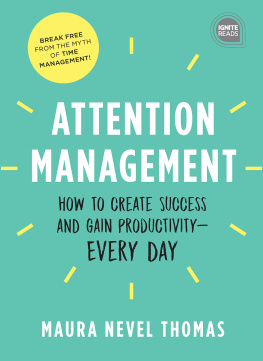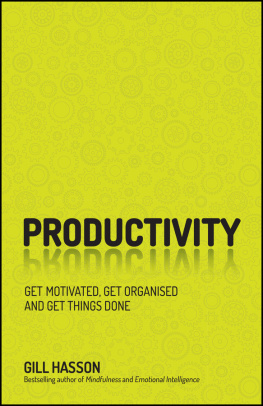Part I: Managing Your Attention
Chapter 1: Stop Trying to Manage Your Time
Chapter 2: Changing Your Mind: Attention Management
Chapter 1
Stop Trying to Manage Your Time
In this chapter
- Regaining control of your attention
- The lure of multitasking
- New kinds of ADD
- Focusing and choosing
Time management is a twentieth-century term that has far outlived its usefulness. The longer into the twenty-first century people continue to frame their productivity in terms of time management, the less efficient they will be. Thats because the traditional tools of time management are a calendar and a clock. However, rapid technological advances have made our lives far too complex to manage with these tools. Putting something on your calendar doesnt mean it will occur, and making time for something doesnt guarantee that youll have the experience you intended.
For example, say you schedule coffee with a colleague, but while you are together, she cant keep her eyes off her mobile device because shes checking her email, texting someone, or searching the Internet for the answer to a question you posed. If shes doing all that, chances are good that she is not truly present in her experience with you. In other words, it would probably not be the meaningful dialogue that you intended when you
scheduled the date, but rather an annoying waste of time. Does this scenario sound familiar? It appears to be a common occurrence in both social and business interactions of the twenty-first century; you spent the time together, but because at least one persons attention was lacking, it didnt have the desired effect.
Its hard to blame your coffee guest for her lack of focused attention. Today, many people carry the world in their pocket in terms of Internet access on their smartphones. With Internet access, you have at your fingertips the answer to virtually any question that pops into your head, random or otherwise. Whether you want to know about the weather or the theory of relativity, the answer is just a few taps away. And not only do you have to contend with your own curiosity and your own scattered attention, but advertisers know that human beings are evolutionarily wired to respond to lights, color, sound, and movement, which are all features that your smartphone offers. Every business in the world is currently studying how to use your smartphone to direct your attention to its service or product.
Advertisers attempt to steal your attention in myriad ways: music and messages played in public places, on-hold advertising, scrolling marquees, commercials and product placement in television, radio, and movies. Many of us make the advertisers job easier by frequently having a screen in front of us, so that we are constantly subjected to banner advertising on virtually every single web page, in-app advertising on handheld devices and tablets, and even messages in our car from our navigation system or in-vehicle security device! Matt Richtel, technology writer for The New York Times , calls this screen invasion. Unfortunately, this invasion of screens, and the resulting distraction, is the cost of indulging in the conveniences and technological progress of the last 50 years.
Given all these demands on your attention, this book proposes that how you spend your time only matters to the extent that you also apply your attention .
The more I study productivity, efficiency, and effectiveness, the more I am convinced that the secret to defending against the constant demands on your attention is learning controland the most important place for you to exert control is over your own attention. When you control your attention, you control your life. In the twenty-first century, time management and information management are no longer as important as attention management .
This chapter illustrates why this issue has serious implications for your productivity, and how this shift in your thinking from time management to attention management affects your effectiveness. This chapter also teaches you how and why to exert more control over your own attention.
Modern Technology: Advantages and Disadvantages
New communication technologies are vastly changing the landscape of human interaction. Social media is the latest incarnation of Internet communication that has volleyed the power back and forth from the hands of the powerful into the hands of the people. In medieval times, information was distributed from the seats of power. The invention of the printing press then provided access to creation and dissemination of information by citizens. The advent of radio and television created one-way media that have enabled those who can afford to broadcast to create mass audiences that are passive recipients of content, a scenario that enables powerful channels of propaganda.
Social media can be defined as any type of public, two-way, one-to-many technology application or platform. Some examples are Facebook, Twitter, blogs, YouTube, Flickr, and the like.
Chat rooms were among the first Internet technologies that enabled one-to-many communication , and they have evolved into social media in its current form (blogs, Twitter, Facebook, and so on), which is the greatest opportunity yet invented for everyday people to have a voice and make themselves heard. These technologies allow back-and-forth communication in real time, literally shaping the evolution of events. The 2011 uprisings in the Middle East and the Occupy Wall Street movement are examples of situations that are propelled and nourished by social media.
Social networking has changed the face of business as well. Although the late 1990s marked the emergence of corporate complaint websites, consumer complaints gained even more power with the growth of Twitter. Now one person having a bad experience with a company can share his or her negative feelings with millions of people in a matter of hours. Tweets appear in Internet search results and end up as stories in mainstream media. As a result, many large corporations have employees dedicated to controlling bad press and resolving customer issues specifically on Twitter and use their corporate Facebook pages as interactive, public customer-service portals.
More Friends = More Distractions
The explosion of opportunities to connect with real and virtual friends online has dramatically affected the number of people with whom we share our attention. One-to-many communication has changed the way we form relationships, removing the obstacle of physical distance. Millions of people now connect and share with others globally, creating friendships with people they have never met in person. Its increasingly common for relationships begun online to result in meaningful partnerships and marriage. Social media has even been credited with preventing suicides. Defining relationships has always been somewhat subjective, but an entire generation is arguably redefining what it means to be a friend and to like something.
Social media is changing not only our external realities, but our internal ones as well. The new capability for live sharing, broadcasting experiences live and in real time, has led to a concept of self as becoming externally manufactured rather than internally developed: a series of profiles to be sculptured and refined in response to public opinion....Your psychology becomes a performance. Its not uncommon these days to be at a concert, conference, or event and find more of the audience live-sharing their experience rather than fully absorbing it.
These changes in the breadth and depth of external relationships we keep updated online have increased the popularity of the field of attention research. Journalists and academics alike are studying, discussing, and publishing information about the effects of being so frequently connected to a screen, whether we are in a car, at our desks, or walking down the street. Recent research has found that when people keep their brains busy with digital input, they are forfeiting downtime that could allow them to better learn and remember information, or come up with new ideas.









